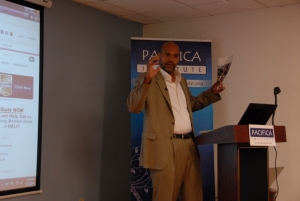Lecture Series: KPCC Reporter Brian Watt (March 22nd, 2012)
In mid-July of 2011, it seemed to KPCC reporter, Brian Watt, that store workers of Ralphs, Vons and Albertsons, the three major grocery chains, were once again getting ready to carry out a strike.
Sensing the possibility, Watt preemptively set out to gather and all the relevant information he could. Watt wanted to be prepared to provide KPCC listeners, his listeners, with the context and background they could use in the case that his suspicion of a strike bore out.
Watt spent four weeks brainstorming, researching, interviewing, and finally putting his story together. By the time Watt’s efforts hit the radio, they had been distilled into a four minute radio segment.
During his talk Thursday at the Pacifica Institute in Los Angeles, Watt offered his audience several behind-the-scenes forays into the inner workings of radio.
Before starting his presentation, Watt first took a moment to compare the mission statements of KPCC and Pacifica institute, noting that both organizations, in essence, strive to further the same goals of building relationships, connections and bonds within and beyond the community.
“We are kind of doing the same thing,” Watt said, “We’re taking different and sometimes similar methods to reach the same goals so I wanted to applaud the Pacifica Institute and say that we, [KPCC], are with you.”
During his presentation, Watt played two stories for the audience.
Watt’s commentary on the stories’ creation revealed a dichotomy in how the two works came to be the final products aired on KPCC.
Watt’s first story, titled “Supermarkets, workers fight old battle with new risks,” detailed the effects that the grocery store worker strike in 2003 had on the big chains – particularly in terms of the customers lost by competing grocery stores to one another.
Watt explained that the four weeks taken to prepare were largely spent bouncing among locations.
“…it took place in three different places,” Watt said, “First place, the Trader Joe’s in Palos Verdes. So we’re at Trader Joe’s, now we need a shopper who not only goes to Trader Joe’s but who started going to Trader Joe’s during the last strike.”
Finding and interviewing customers in different parts of LA who fit those criteria was difficult, Watt said, even with the use of a new system called the Public Insight Network, which is a database of people who opt to become sources for journalists.
“This is an example of a story that took a while,” Watt said, “a lot of the stories I do are like this, they take a while but then the magic of radio is that sometimes you’re just somewhere and you talk to the right people at the right place at the right time and the next story is a perfect example of that.”
Watt’s second story, about three minutes long, was titled “South LA church displays photos of 10 ‘Grim Sleeper’ victims.” It centered on interviews with people who had come to view the pictures of the ‘Grim Sleeper’ victims.
“The first thing I want to say about that story is that I almost didn’t go.” Watt said.
Earlier that morning, Watt had covered what he thought was a very inspirational story of Salvation Army taking a group of underprivileged kids to Target for a free back to school shopping spree.
He was ready to start pushing the pieces together on his back to school story, when upon the request of his boss, he got in his car and drove to South LA to see what was going on.
Once there, Watt was moved by how many people had turned up to see the victims.
Chris McNair, a 52-year-old contractor, one of the people Watt interviewed, was on his lunch break when he saw the photos outside the church decided to stop his car to write a message to one of the victims he had known.
McNair had also briefly known the alleged murderer, Lonnie Franklin, Jr.
“It’s eerie,” Watt said, “When you meet someone who knows a victim but who also interacted with the killer and is sort of just realizing that as they’re talking to you. I wanted that on the radio.”
He also met a woman who recognized one of the victims as a former student of hers, and while she kept affirming that she did not want to talk to Watt, she continued to talk to him.
“…every time I tried to take distance, she would bring me a little bit closer and say a little bit more,” Watt said “it was one of the more magical moment in radio for me…when you discovered you can’t always be the aggressive, go get em’, get the story get out [kind of reporter]. Sometimes you just need to let the moment breathe.”
Contrary to the process of grocery store story, Watt didn’t have to look for people that fit a certain criteria and he didn’t have to go to different locations. He just listened to the people.
He stayed there for an hour to an hour and a half, took a few pictures and got back to the studio just a little before 4 p.m., to get the script ready before the 4:30 p.m. cut off for stories running that night on KPCC.
“It was just one of those perfect days,” Watt said, “This was just one of those stories where the people and the characters were so strong that there wasn’t that much writing to do.”
All that was left to do Watt said “Was for me to step back and to let the people in the story talk.”

